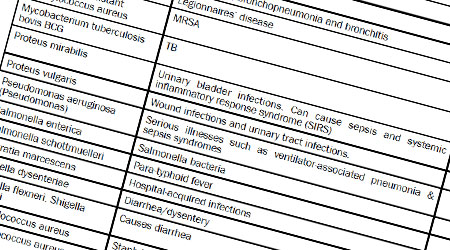
Are you using the proper disinfectant for your facility? Just because a disinfectant has an EPA registration, it doesn’t necessarily mean it will kill the microorganisms you are most concerned with eliminating. In order to properly disinfect a facility, it is imperative to know the bacteria, viruses, and fungi involved and to use an EPA-registered disinfectant effective against those particular microorganisms.
The EPA registers a disinfectant based on tests which prove the product’s effectiveness on named viruses, bacteria, and fungi. Once effectiveness is verified for particular microorganisms, the manufacturer lists those organisms on the product’s label. Then, it is up to the user to determine if the disinfectant will address the disinfecting need, which is done by matching the listing on the disinfectant’s label with the particular microbe targeted for elimination.
However, matching the scientific names on the product label with the actual microorganism to be eliminated can be a challenge to those who do not hold a scientific degree.
To the rescue is QuestSpecialty’s free Microbial Identification Chart which lists the most common scientific names for microbes found on disinfectant labels and their association with commonly known infections or the more commonly known names of the microorganisms.
For example, if your office building is concerned with the spread of pneumonia, you would need a disinfectant with Klebsiella pneumoniae listed on its label. A product that instead lists Canine parvovirus would not be helpful, as that virus is associated with CPV, a highly contagious viral illness affecting dogs.
“It is imperative to use the proper disinfectant to address a facility’s disinfecting needs, however, we noticed many facility managers had difficulty in properly matching the scientific name of a microorganism with the threat they wanted to address,” points out Alex Pratt, lead chemist for QuestSpecialty Corporation. “Many people will use a product that appears to have the most number of claims, thinking it will address any problem they may have. However, that boils down to using guesswork to eliminate a particular microbial threat. This chart helps eliminate the guesswork.”

 The Down and Dirty on Cleaning in Virus Season
The Down and Dirty on Cleaning in Virus Season How Surfactant Use is Expanding in Commercial Cleaning
How Surfactant Use is Expanding in Commercial Cleaning Operational Excellence Series 2025: Better Budgeting
Operational Excellence Series 2025: Better Budgeting